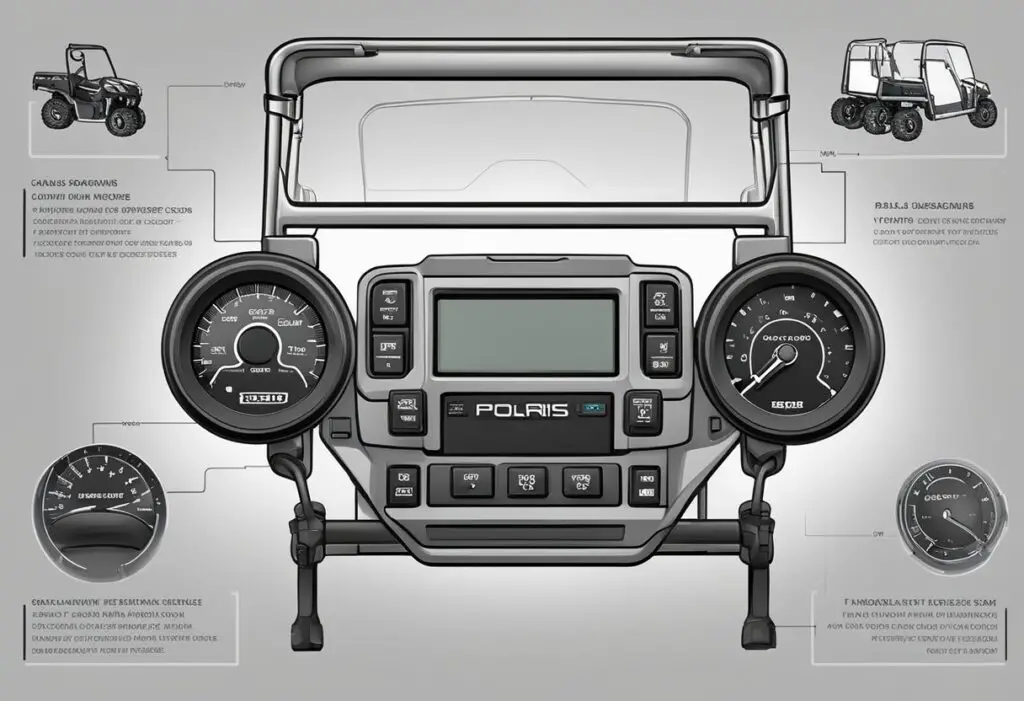When the check engine light illuminates on the dashboard of a Polaris Ranger 800, it serves as an indication that the vehicle’s onboard diagnostic system has detected an issue. The check engine light is one of the most crucial alerts, signaling the need for immediate attention to the vehicle’s engine or associated systems. It is important for owners to understand the meanings of various error codes displayed by their Polaris Ranger, as these codes provide insight into the nature of the problem and the urgency of the required maintenance or repairs.

Each error code corresponds to a specific issue, ranging from minor sensor malfunctions to more significant engine troubles. The owner’s manual for the Polaris Ranger 800 contains a comprehensive list of diagnostic trouble codes (DTCs) and their meanings, which can assist owners in identifying the initial steps for troubleshooting. Some common error codes include low output voltage, misfire codes, and coolant temperature sensor warnings, which could imply a range of issues from loose wires to faulty electronic control units.
Addressing the cause of a check engine light promptly is essential to maintaining the performance and longevity of the Polaris Ranger 800. Owners are encouraged to consult their manual or a certified technician to ensure that the correct procedures are followed to diagnose and fix any issues revealed by the check engine light. Proper understanding and timely response to these error codes can help avoid potential damage to the vehicle and ensure safe, reliable operation.
Understanding Check Engine Light Indicators

When the Check Engine Light illuminates on a Polaris Ranger 800, it serves as a critical alert that the vehicle’s onboard diagnostic system has detected a malfunction. This section will help users comprehend what the light indicates, the importance of diagnostic trouble codes, and how to interpret specific fault codes.
Interpreting the Check Engine Light
The Check Engine Light is a tell-tale sign that there is an irregularity within the engine or related systems. It should not be ignored, as operating the vehicle without addressing the issue can lead to further complications.
Role of Diagnostic Trouble Codes (DTCs)
Diagnostic Trouble Codes (DTCs) are the vehicle’s method of communicating the nature of the fault. These codes are retrieved via a scan tool, providing a starting point for troubleshooting. The DTCs consist of a five-character alphanumeric string that identifies the specific problem area.
Understanding Fault Codes
Here is the significance of some common Fault Codes that may appear:
- Error Code 3598: This indicates a low output voltage from the ECU, often due to a loose wire, bad connection, or a faulty ECU.
- Misfire Codes 65590 / 65591: Typically resolved with new NGK spark plugs, suggesting an issue with ignition or fuel delivery.
- Code 746-5: This code sometimes can be reset by disconnecting the battery, implying an electrical or sensor issue.
It is crucial for Polaris Ranger 800 owners to recognize that these Fault Codes are integral to diagnosing and resolving issues accurately.
Diagnostic Process

In addressing the check engine light on a Polaris Ranger 800, the diagnostic process is a crucial step. It involves using the vehicle’s onboard diagnostics to extract error codes from the Electronic Control Unit (ECU) and interpret these codes to identify potential engine faults.
Using the Key and Mode Button to Retrieve Codes
To initiate the diagnostic process for a Polaris Ranger 800, the user must first use the ignition key. With the key, they turn the vehicle on, without starting the engine. The mode button, usually found on the instrument cluster, is pressed and held to access the diagnostic screen. The screen will then display any diagnostic codes that the ECU has recorded. These codes appear as a combination of numbers and letters, indicating specific engine fault codes. It is important for the owner to have access to the owner’s manual or Polaris.com for a comprehensive understanding of what each code signifies.
Interpreting the Error Screen
Once the error screen is visible, it displays the specific diagnostic code related to the check engine light. Each diagnostic code corresponds to a particular engine fault, ranging from minor sensor malfunctions to more serious engine issues. Interpreting these codes often requires the owner to refer to the owner’s manual, where there is typically a table or list detailing the meaning of each code. Alternatively, one can find resources on Polaris.com that provide further information regarding the diagnostic codes. It is imperative for owners to accurately interpret the error screen to determine the appropriate corrective action.
By following a methodical diagnostic process, owners can pinpoint the reasons behind the activation of the check engine light on their Polaris Ranger 800 and take informed steps towards resolution.
Common Engine Light Codes and Solutions

When the check engine light comes on in a Polaris Ranger 800, it is crucial to understand the specific error codes and the appropriate corrective actions to take. This section details the common engine light codes, providing an understanding of the potential issues and guidance on troubleshooting.
Overviews of Specific Engine Light Codes
- 41: Air Temp Sensor: Indicates a problem with the air temperature sensor, which can affect engine performance. Solutions include checking connections and ensuring the sensor is not damaged or disconnected.
- 42: Engine Temp Sensor: If this light is on, the engine temperature sensor may be sending incorrect signals. Examine the wiring and sensor for signs of damage or loose connections.
- 43: TPS 1 (Throttle Position Sensor): Reflects an issue with the throttle position sensor, which could lead to erratic engine behavior. One should inspect the sensor’s connections and voltage to ensure proper operation.
- 45: Barometric Pressure Sensor: This code indicates that the barometric pressure sensor, which plays a role in adjusting the engine’s air/fuel mixture, might be faulty. Check sensor functionality and wiring integrity.
Troubleshooting Error Messages
- Engine Speed and Speed Sensor: Anomalies in engine speed readings can result from a faulty speed sensor. Verifying the sensor’s integrity and its connections can help to resolve error messages related to engine speed.
- Battery Voltage: Low battery voltage might cause various sensor malfunctions. Ensure the battery is charged properly and examine the battery voltage connections for any corrosion or loose wires.
- Connections and Wiring: Many errors can be traced back to poor connections or damaged wiring. It is essential to inspect all related connectors and wiring to ensure reliable communication between the sensors and the engine control unit.
- Voltage and Sensors: Intermittent voltage levels can cause sensors to send erroneous signals. Check for consistent voltage supply to avoid false engine error messages.
Electrical System Analysis

Ensuring the proper function of the Polaris Ranger 800’s electrical system is critical for optimal performance. This section focuses on battery health and wiring integrity as primary factors in troubleshooting engine light codes.
Battery and Voltage Checks
Battery Condition: Regularly inspect the battery for physical damage and corrosion. To ensure it’s holding charge, a voltmeter should read 12.6 volts or higher on a fully charged battery. Anything below 12.4 volts indicates charging is required.
- Voltage Above Normal: If voltage readings are significantly above 13.8 volts when the engine is running, this indicates an overcharge condition.
- Voltage Below Normal: Conversely, readings below 12.0 volts under load suggest a weak battery or poor charging.
Load Testing: It’s advisable to perform a load test. Sustaining 9.6 volts for 15 seconds at half the cold cranking amps rating indicates a healthy battery.
Evaluating Wiring and Connectors
Wiring Inspection:
- Look for any signs of chafing, wear, or breaks that could lead to an Open Load or a Short to Ground situation.
- Shorted to High Source or Shorted to Low Source: Any abnormal exposure to high or low voltage sources can damage wiring integrity.
Connector Analysis:
- Ensure connectors are free of corrosion, secured tightly, and without damage.
- Electrical contact points must be clean and snug, as a loose connection can result in intermittent power delivery or sensor readings.
By rigorously inspecting these components, any discrepancies that might trigger a check engine light can be identified and resolved.
Sensor and Circuit Diagnostics
When the check engine light illuminates on a Polaris Ranger 800, it often signifies an issue with a sensor or circuit. Diagnosing these problems effectively requires an understanding of the specific roles sensors play and recognizing signs of circuit malfunctions.
Understanding Sensor Functions
Sensors are the nervous system of the Polaris Ranger 800, each serving a specific role to ensure optimal engine performance. The Throttle Position Sensor (TPS) and ETC Accelerator Position Sensor coordinate to provide precise throttle control. The Barometric Pressure Sensor and the Manifold Absolute Pressure (MAP) Sensor work together to determine the air pressure within the intake manifold which is crucial for calculating the air/fuel mixture. The Idle Air Control (IAC) regulates engine idle speed, adjusting the air intake as necessary.
The Vehicle Speed Sensor (VSS) translates mechanical motion to an electrical signal to gauge the vehicle’s speed, while the Intake Air Temperature Sensor measures the temperature of the air entering the engine. Furthermore, the Engine Temperature Sensor monitors the engine’s operating temperature.
Lastly, the Oxygen Sensor assesses the exhaust gases, providing feedback on combustion efficiency, which helps to optimize fuel economy and reduce emissions. The Air Temp Sensor is closely associated with the MAP, providing data for air density and thus, the correct amount of fuel for combustion.
Investigating Circuit Issues
Circuit issues can be equally as disruptive as sensor failures and often present through similar check engine light codes. Diagnosis should begin with a thorough inspection for obvious signs like frayed wiring or loose connections. When investigating, one must ensure that wiring harnesses and connectors are secure and free from corrosion.
Circuit integrity is pivotal; a multimeter can be utilized to check for continuity and proper voltage levels across sensor circuits. Resistance values should be within specifications; an abnormal reading may indicate a short or open circuit. Notably, circuit problems can often cause erratic sensor readings, leading to improper adjustments by the engine control unit (ECU).
Sensor and circuit diagnostics are crucial for maintaining the health of a Polaris Ranger 800. Regular checks and maintenance of these components are recommended to ensure longevity and reliability of the vehicle.
Engine and Mechanical Diagnostics
Proper engine and mechanical diagnostics for a Polaris Ranger 800 involve scrutinizing the engine’s temperature and cooling efficiency while also examining the fuel and ignition systems in detail. These diagnostic assessments help identify specific errors indicated by trouble codes, ensuring that the vehicle operates at optimal performance levels.
Engine Temperature and Cooling Checks
The engine temperature of a Polaris Ranger 800 is pivotal for maintaining performance. To ensure proper engine temperature regulation:
- Check the thermostat for correct operation.
- Inspect cooling system for leaks or obstructions.
- Verify that the radiator and cooling fans function appropriately.
Diagnostic trouble codes (DTCs) related to engine temperature may indicate issues with thermostats or cooling mechanisms.
Analyzing Fuel and Ignition Systems
Ensuring the health of the fuel and ignition systems is crucial for preventing engine misfires and ensuring efficient fuel combustion. Key steps include:
- Examining Fuel Injector 1 and Injector 2 for blockages or malfunctions.
- Testing ignition coils for proper spark generation.
Misfire codes might arise from issues with either fuel injectors or ignition coils. Addressing DTCs associated with these can help pinpoint which cylinder is experiencing a misfire and the root cause of the issue.
Enhanced Diagnostic Techniques
To effectively diagnose issues in Polaris Ranger 800, leveraging advanced diagnostic tools and accurately interpreting failure mode identifiers are critical.
Utilizing Advanced Diagnostic Tools
Professional mechanics often use specialized equipment to read and interpret diagnostic trouble codes (DTCs) from a Polaris Ranger 800’s Electronic Control Unit (ECU). This process begins with connecting a laptop or dedicated handheld scanner to the vehicle’s diagnostic port. The service manual is an essential resource, guiding technicians through the correct diagnostic procedures.
Core Diagnostic Steps:
- Connect the diagnostic tool to the ECU
- Retrieve DTCs and record the Code Count
- Analyze DTCs alongside the Suspect Parameter Number (SPN)
Table of Recommended Tools:
| Tool Type | Purpose | Compatible With |
|---|---|---|
| Laptop-based | Comprehensive diagnostics, code reading/clearing | App-specific connection |
| Handheld | Quick code retrieval | Polaris diagnostic port |
| Service Manual | Step-by-step diagnostic guidelines | Polaris Ranger 800 |
Interpreting Failure Mode Identifiers
Understanding Failure Mode Identifiers (FMIs) is crucial for pinpointing specific problems. Each combination of Diagnostic Trouble Code (DTC) and Failure Mode Indicator (FMI) directs technicians to the probable cause of an issue, as described in the service manual.
DTC and FMI Example:
- DTC: P0302 – Cylinder 2 Misfire Detected
- FMI: 4 – Voltage below normal, or shorted to low source
- Action: Check for faulty spark plugs, wiring, or injector problems.
The service manual provides a detailed list of FMIs associated with each DiagCode, clarifying the type and area of malfunction. By understanding FMIs, technicians can focus their attention on the specific systems that are indicated by these codes.
Addressing Error Code Causes
When facing error codes on the Polaris Ranger 800, it’s essential to systematically approach the underlying issues, typically involving sensor malfunctions or electrical problems. Detailed diagnosis and timely intervention can prevent future complications and ensure the vehicle’s smooth operation.
Repairing Damage and Replacing Parts
- Damaged Wiring: Inspect the wiring for signs of wear, abrasion, or cuts. Faulty wiring often manifests as error codes such as 3598, which may indicate low output voltage. Repair or replace any damaged wires to restore proper electronic control unit (ECU) functionality.
- Connectors: Ensure that all connectors are secure and free of corrosion. Loose or corroded connectors can cause various engine light codes, impacting the electrical circuit’s integrity.
- Engine Temperature: Monitor the engine temperature sensor’s feedback in the diagnostic readings. If the sensor reports abnormal temperatures, it could trigger check engine warnings. Replace the sensor if it’s faulty.
- Fuel Injector: A clogged or malfunctioning fuel injector can cause misfires, identified by codes 65590 and 65591. Cleaning or replacing the injectors can resolve these misfire issues. Remember to check for proper electrical connections as well.
- Ignition Coil: The ignition coil’s health is critical for the engine’s proper ignition. A failure here can lead to misfires; therefore, testing and, if necessary, replacing defective coils is necessary.
- Throttle Position Sensor (TPS): Fluctuating idle and engine performance issues may point toward a TPS malfunction. A precise TPS calibration ensures accurate throttle input is relayed to the ECU.
- Manifold Absolute Pressure Sensor (MAP): The MAP sensor significantly influences fuel delivery and ignition timing. Irregularities or sensor failures can lead to engine inefficiency and potential error codes. Inspect and replace this sensor if diagnostics suggest it is the fault source.
Preventive Maintenance and Best Practices
Adhering to preventive maintenance schedules and best practices can mitigate the risk of performance issues and false positive error codes in a Polaris Ranger UTV. Proper and timely actions ensure the longevity and reliability of the vehicle.
Routine Inspection and Care
Regular inspection and timely care are critical to preventing unexpected check engine codes and maintaining optimal performance of a Polaris Ranger. Owners should perform the following checks:
- Oil and Coolant Levels: Ensure that the oil is within the recommended range and the coolant is at appropriate levels to prevent engine overheating.
- Air Filter: Inspect and clean or replace the air filter as advised to prevent contaminants from entering the engine.
- Brake Pads: Check the condition of the brake pads to ensure sufficient material is present for safe stopping.
- Electrical Connections: Look for loose or corroded connections that could lead to voltage issues or false error codes.
Consulting the Owner’s Manual and Service Manual
The Owner’s Manual and Service Manual are invaluable resources for UTV owners. Specifically, they provide:
- Diagnosis and Troubleshooting: Detailed steps to diagnose and address error codes and performance issues.
- Maintenance Schedule: Key information on timing for critical maintenance activities.
- Specifications: Accurate specifications for parts and fluids to use, which are essential for both daily maintenance and resolving error codes.
By meticulously following the Polaris Ranger manuals and adhering to a routine inspection schedule, owners can vastly reduce the likelihood of serious issues and maintain vehicle performance at its peak.
Troubleshooting Support Resources
Effective troubleshooting of Polaris Ranger 800 check engine light codes hinges on reliable support resources. This section will direct owners to those resources, aiding in the swift resolution of error codes through online platforms and professional assistance.
Online Help and Communities
Owners experiencing check engine light codes can find a wealth of information through Polaris’s Online Publication Portal. It offers access to diagnostic trouble codes, detailed repair, and maintenance guides. For instance, error codes like 3598 and 65590/65591 can often be addressed with reliable fixes. The Owner’s Manual, accessible via Polaris.com, is a vital resource, providing step-by-step instructions on various codes. Additionally, online forums and communities offer a space where owners can share personal experiences and solutions related to Polaris Ranger error codes.
Professional Service Assistance
When personal troubleshooting is not an option, or the error codes indicate a more complex issue, seeking professional service assistance is recommended. Trained technicians can interpret Polaris Ranger check engine codes with precision and provide appropriate repairs. The authorization and support from a local Polaris dealer guarantee that troubleshooting and fixes are conducted in line with Polaris’s standards, ensuring the longevity and safety of the vehicle.
Frequently Asked Questions
Understanding the check engine light codes on a Polaris Ranger 800 is vital for proper troubleshooting and maintenance. This section aims to provide clear answers to common questions regarding these codes and the steps to address them.
How can I retrieve and interpret the check engine light codes for a Polaris Ranger 800?
One can retrieve check engine light codes from a Polaris Ranger 800’s instrument cluster where they typically flash. For interpretation, the vehicle’s manual contains a list of codes and their corresponding issues, or one might consult a professional mechanic.
What are the steps to reset the check engine light on a Polaris Ranger 800?
To reset the check engine light on a Polaris Ranger 800, one must first rectify the issue that triggered the light. After the repair, they can disconnect the battery for a few minutes, which may reset the vehicle’s computer system and extinguish the light.
Which check engine code indicates a misfire in a Polaris Ranger 800?
The check engine code that typically indicates a misfire in a Polaris Ranger 800 will start with P0300 followed by another digit that specifies which cylinder is misfiring (e.g., P0301 for cylinder 1).
What does a consistent check engine light signal on a 2018 Polaris Ranger 800, and how should it be addressed?
A consistent check engine light on a 2018 Polaris Ranger 800 typically signals a persistent engine issue that should not be ignored. It warrants a diagnostic check-up using an OBD-II scanner to identify the specific fault code, followed by relevant repair work.
Are there any common engine issues in the 2016 Polaris Ranger 800 that trigger check engine codes?
The 2016 Polaris Ranger 800 models may display check engine codes that may be indicative of sensor failures, such as for the throttle position or oxygen sensors. Electrical issues or fuel delivery problems are also not uncommon.
What is the recommended course of action after identifying a check engine code on a 2012 Polaris Ranger 800?
Upon identifying a check engine code on a 2012 Polaris Ranger 800, the recommended action is to consult the service manual for guidance, perform a thorough inspection for the identified issue, and address it promptly either through self-repair or by seeking professional service.

Leave a Reply